Вестник Южно-Уральского государственного университета. Серия: Машиностроение @vestnik-susu-engineering
Статьи журнала - Вестник Южно-Уральского государственного университета. Серия: Машиностроение
Все статьи: 673
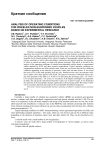
Analysis of operating conditions for wheeled non-suspended vehicles based on experimental research
Краткое сообщение
Wheeled unsuspended machines include many slow-moving machines whose transport speed does not exceed 30-40 km/h. A distinctive feature of these machines is that the wheels and axles of these machines are rigidly attached to the frame, with no elastic and damping devices responsible for the smooth running of the vehicle. Examples of unsuspended wheeled machines are tractors, combines, as well as other agricultural, construction and special machines, the operation of which is carried out mainly on roads with uneven pavement. This article is devoted to the analysis of the operating conditions of wheeled non-suspended vehicles based on experimental studies obtained by NATI and other research organizations. Typical operating conditions for suspensionless machines are fields and dirt roads, which are very diverse and can be in different conditions depending on the intensity of operation, repair work and other factors. It was found that most (55%) of the total operating time per year, wheeled tractors carry out transport work, and a smaller (45%) they operate in the fields. The speed of movement of wheeled tractors during most operations in the fields is 5-10 km / h, for harvesting hay and silage crops - 10-15 km / h, for transport operations - 20-25 km / h. An analysis of the heights and lengths of irregularities in fields, dirt and gravel roads showed that their values vary in narrow ranges. It was found that the spectrum of the microprofile changes significantly with increasing speed. This makes it difficult to accurately determine the ranges of the most probable disturbance frequencies.
Бесплатно
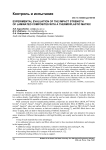
Experimental evaluation of the impact strength of laminated composites with a thermoplastic matrix
Статья научная
Tensile tests were performed to obtain the quasi-static mechanical properties of the aramid fabrics (Twaron®, RUSLAN®-SVM). The elastic modulus of filaments, pulled out from the fabrics was measured with compact testing machine INSTRON 5942. Filaments pull-out tests were carried out to compare the frictional forces in different aramid fabrics. Eight various types of ballistic panels with the thermoplastic matrix based on polyethylene were fabricated and two types ballistic panels based on UHMPE (Dyneema®). Extensive ballistic tests have been carried out on various ballistic panels using 6.35 mm steel ball. Special powder gun stand for acceleration of projectiles with terminal velocity up to 900 m/s was developed The ballistic performance was assessed in terms V50 threshold as well as post V50 limit. After the test, the comparison was produced of effectiveness between all of materials used in this work. Laminates based on UHMPE fibers are much better than others in respect to the values of on indicators of V50 (about 10 %) and of the absorbed energy (about 25 %) under high-velocity impact conditions. But their energy absorption capability can sharply drop down when projectile's velocity exceeds the ballistic limit. When selecting reinforcing aramid fabric for ballistic application, it is important to consider not only the mechanical properties of the fibers and the type of fabric construction, but also the material should have good results on all parameters of ballistic efficiency such as filaments width, etc. Best aramid fabric composite was SVM S125 with twill construction and LDPE films.
Бесплатно
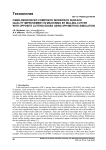
Статья научная
Unidirectional fiber-reinforced composite workpieces are often machined in practice. During such cutting process stronger fibers are bended more than weaker matrix and an interfacial debonding between them is occurred under machined surface. It deteriorates working properties of composite and so debonding reduction is a vital technological problem. One of the perspective ways to diminish such debonding is to substitute the orthogonal cutting by the oblique one. This decision is confirmed by known practice of milling cutter design. Milling cutters with the continuous helix edges and with interrupted ones with a large tool cutting edge angle are often used. In this case fiber deformations in a cutting zone are significant. To diminish such deformations the hypothesis about efficient use of opposite cutting edges location with a large tool cutting edge inclination is assumed. This hypothesis is checked by using of SPH method with micro-simulation of cutting of metal-matrix composites (steel fibers and aluminum alloy matrix). Johnson-Cook approach is used for both materials. Obtained qualitative deformation pictures confirm this hypothesis. On this basis a new milling cutter design with tool major cutting edges located as a chevron on a cylindrical surface with alternate arrangement is suggested. Computer simulation of such edges operation shows minimal fibers deformations in cutting zone. At the same time, undesired excessive chip packing in a zone between the adjacent cutting edges is not observed. The obtained results are preliminary considering the limited computer model size and no experiment verification made.
Бесплатно
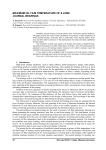
Maximum oil film temperature of 8-lobe journal bearings
Статья научная
Multilobe journal bearings of steam turbines have well-known thermal problems. The paper presents the results of the calculations of maximum oil film temperature of8-lobe journal bearings. Generally, there is small effect of the bearing relative clearance and lobe relative clearance on the displacement of journal and static equilibrium position angles.The orientation of load with regard to the bottom lobe (lobes) of multilobe bearings affects the maximum oil film temperatures of oil film. Also, the bearing geometry parameters such as the bearing relative clearance, lobe relative clearance cause the variation in the maximum oil film temperature. It was stated in this investigation that an increase in the lobe relative clearance and journal rotational speed causes the decrease in the maximum oil film temperature.
Бесплатно

Means for studying the stability of the characteristics of an automated brake drive
Статья научная
A brake drive is a set of mechanisms that are used to transfer energy from a source to stop devices. In addition, the brake drive is responsible for controlling this energy during its transmission to implement braking. Brake drivers are classified into simple (using human muscular strength) and automated (using additional mechanisms that enhance the muscular strength of the driver or completely replace it). During vehicle use, changes occur in the braking system, which are the result of the impact on the braking system of operational factors: the beating of the surface of the brake disc, a change in the mass of the brake pad, a decrease in the radial stiffness of the hose walls, etc. The occurrence of these factors affects the stability of the characteristics of the elements of the chain “modulator ABS - brake mechanism”. The instability of the braking system characteristics is one of the reasons for the decrease in the braking efficiency of the car and the safety of the vehicle, as it has a direct impact on the quality of the control commands. Improving the operational properties of vehicles with automated braking systems is an urgent scientific and technical problem. To study and improve the operational properties of the vehicle, a laboratory semi-natural stand of an automated car braking system was designed and assembled. It allows simulating the operating processes of the drive, as well as assigning any operating modes of the braking system The article studies the possibility of applying the method of the virtual-physical modeling method when researching and improving operational properties of automotive brake automated systems on model stands, which makes it possible to successfully identify the instability of existing brake systems, and also lays the foundation for the effective creation of elements of unmanned vehicles.
Бесплатно
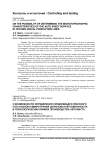
Статья научная
One of the important parameters for assessing the surface quality of a car sheet are parameters such as and RPc. These parameters describe the average value of the profile ordinate modulus and the average value of the number of peaks per unit length of the profile, but they do not provide complete information about the topographic structure of the rough surface. In this paper, as an alternative, we propose the use of complex parameters of the RMS slope angle of micro faces of a rough surface and – correlation distance of a rough surface profile. RΔq is a complex parameter. It simultaneously takes into account both the altitude and frequency parameters of the surface profile. Its values are more rigidly correlated with the coefficient of dry and viscous friction, with the strength characteristics of thinlayer materials, with the oil absorption capacity of the surface layer. The parameter τe is used for very smooth surfaces. It has a clear physical interpretation as the distance above which the correlation relationship between the surface ordinates is lost. This distinguishes it from the empirical parameter R Pc The paper describes the technique of measuring and τe by reflectometric method by scattered laser radiation indirectrices (SLRI) and software tools for analysing SLRI by comparing experimental and theoretical data. Examples of the use of this methodology and software tools for determining the surface parameter of both coldrolled and galvanised automotive sheet are given. The results of this work can be used for the development and implementation of devices for noncontact measurement of the most important tribological surface characteristic in the technological lines of automotive sheet production.
Бесплатно
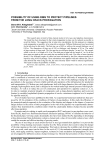
Possibility of using ribs to protect pipelines from the long crack propagation
Статья научная
This research aims to build a finite element model of oil or gas steel pipelines transmission. The model has been developed in that crack propagation in pipes can be reduced as possible to avoid the failure. The suggestion that is taken into consideration for this purposeis to stopping crack propagation as possibly, is by using ribs as arresters. Different thicknesses have been tested for the ribs used in this study. The first one was of 0.02 m, while as the second thickness was of 0.05 m. The dimensions of pipe are of 0.01 m thickness, and diameter of 0.5 m. The model of pipe consists of three parts. The first part has two different lengths 2 m and 3 m. The second, which is the rib, is of length of 0.15 m. The third part of pipe has the length of 1 m. So all the three parts are made up the case study that was studied in this work. The value of stress intensity factor K1 for different lengths of cracks has been calculated by the finite element model deve-loped by using ANSYS package. These calculations were applied with and without ribs. The results showed that when using the ribs, the stress intensity factor would be reduced significantly. This leads to reduce the possibility of failure.
Бесплатно
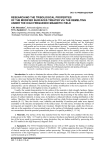
Статья научная
In the article the cladded surface on the 42Cr4 steel under high frequency magnetic field were remelted and modified via TIG (Tungsten-Inert-Gas) welding and the tribological proporties of the specimens were analysed after experimenting at the tribosystem - “ball on disc” with paraffin and on the basis of the tribological, physical - mechanical properties the friction coefficient and wear resistnace of them were evaluated. The productivity and quality of the surface via the application of the additional magnetic field to the remelting process have been increased, because of the additional magnetic field in the weld pool. Under the influence of the magnetic field the molten material is rotated and the additional induced temperature increases the melting velocity. The magnetic rotation mix of alloys and gives to the surface high homogeneity. It has been found that via the plasma treatment of the surface under high frequency maqnetic field the mechanical and tribological properties of the specimens have been improved. The new technology can be applied to the researching and treating of the materials in high frequency magnetic field to increase the quality and efficiency of the processes, So that the methods can be applied for increasing the Hertzian contact pressure, their tribological properties and repairing of the parts.
Бесплатно
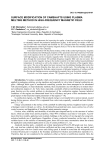
Surface modification of camshafts using plasma melting method in high-frequency magnetic field
Статья научная
Continuous requirements for improving the quality of machines requires new investigation to constantly increase the production performance of parts. In this article, the surface of the cast iron EN-GJV-400 was remelted and modified via TIG (Tungsten-Inert-Gas) welding separately and simultaneously under high frequency magnetic field, as well as the microstructure and hardness of the specimens were compared. It has been found that with the plasma treating of the surface under high frequency magnetic field the mechanical and tribological properties of the specimens have been improved. The hardness of the specimens from the cast iron EN-GJV-400 was increased after the surface remelting with high frequency and low energetic magnetic field. The microstructures of the modified surfaces through the conventional TIG and high frequency magnetic field were also not same. The reason was that the magnetic energy in the molten material in the latter method caused additional temperature in weld pool as well as the rotation of the it in the direction of the magnetic induction vector. The size of the grains has been increased via the additional heating effect and at the same time the dendrite branches have been cut to the smaller parts. The technology can be applied for the increasing the Hertzian contact pressure, tribological properties of surfaces and for the alloying and shaping processes considering the magnetic force on the molten material.
Бесплатно
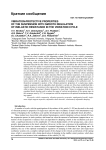
Краткое сообщение
Any mechanical vehicle is equipped with a special device to ensure a constant connection between the wheel system and the supporting system. This device is the vehicle's suspension. The suspension of a motor vehicle performs important functions in the operation of the vehicle. The main ones are: mitigating the physical impact on the vehicle. Also, ensuring the accuracy of the steering, which in turn allows you to maintain the desired direction of the wheels. Another important function that the vehicle suspension performs is to stabilize the vehicle while driving, limiting roll. The quality of suspension performance of the above mentioned functions is greatly influenced by its vibration protection properties. Vehicle suspension vibration protection properties are characterized by its elastic and damping components. In order to improve the vibration protection properties, these characteristics must vary according to different vehicle operating conditions. Because of the complex dynamic effects on the vehicle suspension, it is necessary to investigate and develop new methods of forming dynamic load models under different types of road influences. The article presents a mathematical model of a single-mass single-support oscillatory system with two algorithms for smooth regulation of damping in the oscillation cycle. A theoretical comparative analysis of the vibration-protective properties of a single-mass single-support suspension with an adjustable shock absorber is carried out. It has been established that a smooth decrease in resistance in the region of the middle position of the suspension makes it possible to reduce the resonant vibration frequency by more than 2 times in comparison with an unregulated shock absorber and to reduce the range of vertical accelerations of the sprung mass in the resonance zone by 25 % in comparison with the suspension with optimal instantaneous damping control.
Бесплатно
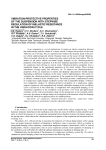
Статья научная
A car suspension is a set of mechanisms. It creates an elastic connection between the undercarriage and the wheels of a motor vehicle. It adjusts the position of the body while the car is moving. The car suspension also reduces the dynamic loads on the motor vehicle undercarriage and wheels. Dynamic loads are the cause of body vibrations. They are formed when the car wheels meet into contact with the road surface. The dynamics of the motor vehicle movement largely depends on the vibration-protective properties of the body suspension. It is the most important parameters of the motor vehicle suspension when driving on uneven roads. Vibration-protective properties have a significant impact on the operational properties of the motor vehicle. These include smoothness, average speed, fuel efficiency, etc. To improve the vibration-protective properties of the car suspension, its elastic and damping characteristics should change depending on different conditions of the motor vehicle implementation. The article investigates the vibration-protective properties of the suspension with stepwise regulation of inelastic resistance in the vibration cycle. The article presents a mathematical model of a single-mass single-support oscillatory system with an adjustable damper. A theoretical comparative analysis of vibration-protective properties of a single-mass single-support suspension with unregulated and instantly adjustable damping in the oscillation cycle is carried out. It was found that, in comparison with unregulated damping, its instantaneous regulation in the oscillation cycle provides a low level and approximate constancy of the vertical acceleration range of the sprung mass in the resonant oscillation zone, but causes an abrupt change in acceleration at the moments when the damping is turned off when the suspension passes its middle position.
Бесплатно
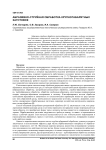
Абразивно-струйная обработка крупногабаритных заготовок
Статья научная
Абразивно-струйная обработка крупногабаритных заготовок, особенно внутренних или фасонных поверхностей, имеет ряд технологических сложностей. В первую очередь, это связано с труднодоступностью зоны обработки и обеспечением высокой производительности. Обоснован новый способ абразивно-струйной обработки, отличающийся тем, что формирование абразивной смеси происходит непосредственно в зоне обработки. Такое решение позволяет создать герметичную зону, тем самым снижает расход абразива и повышает производительность. Эффективной областью применения разработанного способа будет обработка внутренних поверхностей трубных заготовок большого диаметра. Данная технология нашла применение для очистки внутренних поверхностей газопроводов для последующего диагностирования дефектов.
Бесплатно
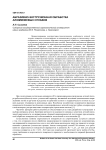
Абразивно-экструзионная обработка алюминиевых сплавов
Статья научная
Проанализированы конструктивно-технологические особенности деталей летательных аппаратов, изготавливаемых из алюминиевых сплавов, и сделан вывод о целесообразности использования абразивно-экструзионной обработки сложнопрофильных и труднодоступных поверхностей таких деталей. Рассмотрены особенности абразивно-экструзионной обработки и характеристики инструмента для данного вида финишной обработки. Приведена схема опытно-промышленной установки для абразивно-экструзионной обработки. Определены цель и задачи исследования. Описана методика проведения экспериментальных исследований и используемое оборудование. Исследование проведено в два этапа. На первом этапе исследована зависимость глубины царапины от геометрических характеристик и вида абразивного зерна при абразивно-экструзионной обработке деталей из алюминиевых сплавов. Эксперимент проведен на установке, имитирующей процесс микрорезания единичным абразивным зерном. Полученные результаты позволяют определить вид, зернистость абразива на каждом этапе обработке, а также предварительно определить требуемое усилие прижатия единичного абразивного зерна к обрабатываемой поверхности. На втором этапе рассмотрена и экспериментально проверена возможность абразивно-экструзионной обработки деталей из алюминиевых сплавов. Эксперимент проведен на опытно-промышленной установке экструзионного шлифования. В результате определено влияние состава рабочей среды (зернистости и концентрации абразива) на эффективность обработки (интенсивность съема металла), что позволяет выбирать оптимальную зернистость абразива и его концентрацию. Определено количество циклов обработки, необходимое для удаления дефектного слоя с деталей, изготавливаемых литьем по выплавляемым моделям, при использовании различного вида абразива. Даны рекомендации по выбору состава рабочей среды и режимов абразивно-экструзионной обработки деталей из алюминиевых сплавов. Определены дальнейшие направления исследований.
Бесплатно
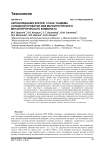
Статья научная
Одной из проблем холодной прокатки тонких полос являются самовозбуждающиеся колебания «чаттер», приводящие к появлению различных дефектов. Высокочастотные автоколебания могут приводить к дефектам, связанным с качеством поверхности, низкочастотные с высокими уровнями амплитуд могут приводить к порывам тонких полос или даже тяжелым авариям самого прокатного стана. Как правило, автоколебания возникают внезапно на больших скоростях проката - больше 20 м/с и тонких полосах - толщина в районе 300-700 мкм. Для нормальной работы стана холодной прокатки необходимо использовать специальные системы контроля вибрационного состояния и предупреждения возникновения автоколебаний. Система контроля по превышению критического уровня вибрации вырабатывает сигналы АСУ ТП стана для устранения автоколебаний. Критический уровень вибрации определяется по спектральному составу с использованием быстрого преобразования Фурье (БПФ). При возникновении автоколебаний преобладают низкочастотные составляющие от 5 до 20 Гц, частоты в диапазоне третьей октавы от 100 до 200 Гц и частоты пятой октавы от 400 до 800 Гц. Стан холодной прокатки 2000 магнитогорского металлургического комбината объединяет пяти-клетьевой стан-тандем и непрерывный травильный агрегат. Штатная система контроля вибрационного состояния на стане отсутствует, предупреждение и устранение автоколебаний происходит в ручном режиме. С использованием исследовательской виброаппаратуры проведены экспериментальные исследования возможности использования технологических параметров для контроля и предупреждения возникновения автоколебаний. Момент возникновения автоколебаний можно контролировать по колебаниям гидравлического натяжного устройства (ГНУ) стана. Обработка сигнала виброперемещения измерительного канала ГНУ проводилась с использованием Быстрого преобразования Фурье (БПФ).
Бесплатно
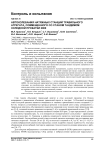
Статья научная
На многоклетьевых станах холодной прокатки, совмещенных с непрерывным травильным агрегатом, автоколебания могут возникать не только на клетях стана, но и на натяжных станциях травильного агрегата. При этом на роликах натяжных станций появляются усталостные трещины, а на поверхности ролика, покрытой полиуретаном, - характерные дефекты. Для контроля автоколебаний на подшипниковых опорах ролика установлены МЭМС-акселерометры. Сбор данных о вибросостоянии происходит параллельно с контролем технологических параметров. Для хранения данных используются базы данных временных рядов. Гибридная база данных позволяет синхронно обрабатывать как технологические, так и вибрационные параметры. При появлении нештатной ситуации можно построить зависимость автоколебаний от технологических параметров. Используя результаты промышленного эксперимента, удалось получить характеристику трения прокатываемой полосы на ролике натяжной станции при малых скоростях движения полосы. При скоростях полосы от 0,5 до 1 м/с характеристика трения находится в переходном режиме, может быть как положительной, так и отрицательной. При отрицательной характеристике трения появляется неустойчивость (автоколебания), при положительной характеристике движение ленты стабилизируется. Обработка сигнала проводилась с использованием быстрого преобразования Фурье (БПФ). По спектральной характеристике можно определить количество полных циклов, действующих на колебательную систему. Имея достаточный объем информации во времени, можно рассчитать количество циклов и оценить остаточный ресурс до возникновения трещин на торцовых поверхностях ролика натяжной станции.
Бесплатно
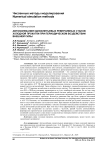
Статья научная
При холодной прокатке тонких полос при определенных условиях возникают автоколебания. Причиной автоколебаний являются нелинейность процесса прокатки, возникновение отрицательного демпфирования в зоне контакта, синхронизация и захват частот в последних клетях многоклетьевых станов, неустойчивость прокатываемой полосы при больших скоростях прокатки. Моделирование процесса автоколебаний – это сложный процесс, при этом используются как экспериментальные, так и численные методы. Существенное влияние на процесс возникновения и прохождения автоколебаний может оказывать и система управления процессом прокатки. При работе одноклетьевых реверсивных станов экспериментально получена зависимость частоты автоколебаний от частоты вращения рабочих валков. Возникновение автоколебаний происходит на частоте, в три раза превышающей частоту вынуждающих колебаний. Кроме того, при работе АСУ ТП формируются регулирующие сигналы на усилие прокатки с частотой, равной частоте автоколебаний. Таким образом, клеть формирует самовозбуждающиеся колебания, АСУ ТП внешнее воздействие на колебательную систему. Регулирование стана осуществляется ПИ- и ПИД-регуляторами, являющимися, по сути, линейными системами. До тех пор, пока стан сохраняет свойства линейной колебательной системы, работа стана происходит штатно. С появлением автоколебаний стан становится существенно нелинейной системой и в управлении станом могут возникнуть проблемы. Используя уравнение Ван дер Поля, провели численный анализ поведения стана при воздействии на него внешних сил, формируемых рабочими валками и АСУ ТП. Показано, что нелинейная автоколебательная система при нулевых начальных условиях и отсутствии внешних сил остается в покое. При внешнем воздействии на систему с частотой, далекой от частоты автоколебаний, в системе возникают вынужденные колебания и формируется автоколебательный режим. При этом могут быть сформированы ультрагармонические колебания. При воздействии на систему силами с частотой, равной частоте автоколебаний, формируется гармоническое захватывание частоты. Формирование условий возникновения автоколебаний одноклетьевого стана может осуществляться непосредственно клетью стана и дополнительно усиливаться воздействием АСУ ТП.
Бесплатно
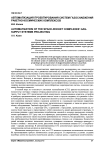
Автоматизация проектирования систем газоснабжения ракетно-космических комплексов
Статья научная
Рассмотрены особенности систем газоснабжения ракетно-космических комплексов. Проанализирован процесс проектирования систем газоснабжения, обосновано использование выбранной системы математических моделей. Приведена предлагаемая методика проектирования, описана структура разработанного программного комплекса.
Бесплатно
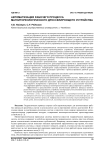
Автоматизация рабочего процесса магнитореологического дросселирующего устройства
Статья научная
Анализируются элементы магнитореологических приводных систем. Рассматривается способ регулирования расхода в управляющей магнитореологической линии при помощи магнитореологического дросселирующего устройства и приводится метод автоматизации рабочего процесса магнитореологического дросселирующего устройства. Описывается способ реализации передачи управляющего сигнала и организации обратной связи по давлению. Приводится способ расчета управляющего сигнала контроллером и пример управляющего алгоритма. В тексте приводятся принципиальные электрические схемы управления рабочим процессом магнитореологического дросселирующего устройства, позволяющие применять подобные магнитореологические дросселирующие устройства в приводах автоматических и мехатронных систем. Также приведен способ осуществления регулирования рабочих процессов магнитореологического дросселирующего устройства при помощи включения в систему дифференциального манометра. Описывается функциональная схема реализации работы тензодатчика разности давления. Авторы предлагают принципиальную гидравлическую компоновочную схему для включения магнитореологического дросселирующего устройства в управляющий магнитореологический контур, предусматривающую термостатирование рабочей среды и позволяющую производить температурное дорегулирование реологических свойств рабочей жидкости. Приведен способ реализации проточного термостатирования рабочей среды магнитореологической системы. Рассматриваются особенности управления системами термостатирования, созданными на безе термоэлектрических полупроводниковых элементов. Описываются преимущества применения предложенной системы. Приводятся статические характеристики дросселирующего устройства, работающего в автоматическом режиме поддержания требуемых расходных характеристик. Производится анализ результатов натурного эксперимента и проводится их сопоставление с результатами численного моделирования рабочего процесса магнитореологического дросселирующего устройства. Эффективность предложенной системы автоматизации рабочего процесса магнитореологического дросселирующего устройства подтверждается полученными результатами численного моделирования и натурного эксперимента.
Бесплатно
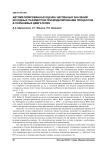
Статья научная
Кратко излагается метод автоматизированного выбора исходных данных для теплового, кинематического и динамического расчетов поршневых двигателей внутреннего сгорания, выполняемых с помощью ЭВМ (ПК). Описываются преимущества такого подхода. Приводятся примеры расчета давлений, температур и сил, действующих в кривошипно-шатунном механизме поршневого двигателя применительно к случаю работы на режиме с полной нагрузкой. Делается вывод о целесообразности автоматизированного выбора исходных данных при выполнении расчетов в учебных целях и НИР.
Бесплатно
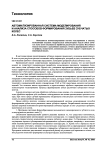
Автоматизированная система моделирования и анализа способов формирования зубьев зубчатых колес
Статья научная
Описывается автоматизированная система моделирования и анализа, позволяющая создавать твердотельные компьютерные модели зубьев зубчатых колес путем эмуляции их обработки различными методами. Полученные модели позволяют в дальнейшем оценивать точность формирования зубчатого профиля, осуществлять компоновку различных передач и производить их инженерный анализ.
Бесплатно

